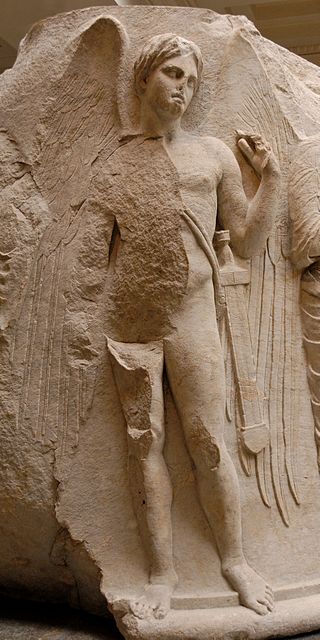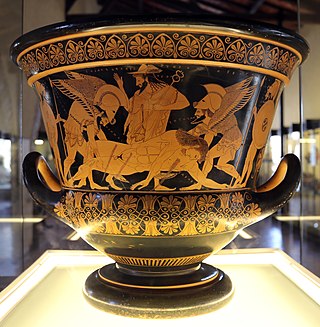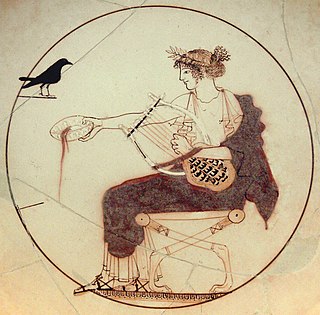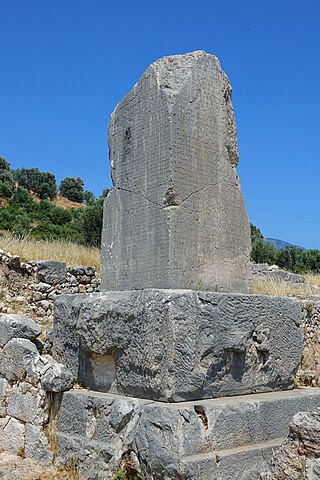
In Greek mythology, Thanatos was the personification of death. He was a minor figure in Greek mythology, often referred to but rarely appearing in person.

Pottery, due to its relative durability, comprises a large part of the archaeological record of ancient Greece, and since there is so much of it, it has exerted a disproportionately large influence on our understanding of Greek society. The shards of pots discarded or buried in the 1st millennium BC are still the best guide available to understand the customary life and mind of the ancient Greeks. There were several vessels produced locally for everyday and kitchen use, yet finer pottery from regions such as Attica was imported by other civilizations throughout the Mediterranean, such as the Etruscans in Italy. There were a multitude of specific regional varieties, such as the South Italian ancient Greek pottery.

A lekythos is a type of ancient Greek vessel used for storing oil, especially olive oil. It has a narrow body and one handle attached to the neck of the vessel, and is thus a narrow type of jug, with no pouring lip; the oinochoe is more like a modern jug. In the "shoulder" and "cylindrical" types which became the most common, especially the latter, the sides of the body are usually vertical by the shoulder, and there is then a sharp change of direction as the neck curves in; the base and lip are normally prominent and flared. However, there are a number of varieties, and the word seems to have been used even more widely in ancient times than by modern archeologists. They are normally in pottery, but there are also carved stone examples.

Euphronios was an ancient Greek vase painter and potter, active in Athens in the late 6th and early 5th centuries BC. As part of the so-called "Pioneer Group,", Euphronios was one of the most important artists of the red-figure technique. His works place him at the transition from Late Archaic to Early Classical art, and he is one of the first known artists in history to have signed his work.

The Euphronios Krater is an ancient Greek terra cotta calyx-krater, a bowl used for mixing wine with water. Created around the year 515 BC, it is the only complete example of the surviving 27 vases painted by the renowned Euphronios and is considered one of the finest Ancient Greek vases in existence.

White-ground technique is a style of white ancient Greek pottery and the painting in which figures appear on a white background. It developed in the region of Attica, dated to about 500 BC. It was especially associated with vases made for ritual and funerary use, if only because the painted surface was more fragile than in the other main techniques of black-figure and red-figure vase painting. Nevertheless, a wide range of subjects are depicted.
Geometric art is a phase of Greek art, characterized largely by geometric motifs in vase painting, that flourished towards the end of the Greek Dark Ages and a little later, c. 900–700 BC. Its center was in Athens, and from there the style spread among the trading cities of the Aegean. Though a not currently accepted concept by all scholars, the Greek Dark Ages were considered to last from c. 1100 to 800 BC and include the phases from the Protogeometric period to the Middle Geometric I period, which Knodell (2021) calls Prehistoric Iron Age. The vases had various uses or purposes within Greek society, including, but not limited to, funerary vases and symposium vases.

The pottery of ancient Greece has a long history and the form of Greek vase shapes has had a continuous evolution from Minoan pottery down to the Hellenistic period. As Gisela Richter puts it, the forms of these vases find their "happiest expression" in the 5th and 6th centuries BC, yet it has been possible to date vases thanks to the variation in a form’s shape over time, a fact particularly useful when dating unpainted or plain black-gloss ware.

The Pan Painter was an ancient Greek vase-painter of the Attic red-figure style, probably active c. 480 to 450 BC. John Beazley attributed over 150 vases to his hand in 1912:
Cunning composition; rapid motion; quick deft draughtsmanship; strong and peculiar stylisation; a deliberate archaism, retaining old forms, but refining, refreshing, and galvanizing them; nothing noble or majestic, but grace, humour, vivacity, originality, and dramatic force: these are the qualities which mark the Boston krater, and which characterize the anonymous artist who, for the sake of convenience, may be called the 'master of the Boston Pan-vase', or, more briefly, 'the Pan-master'.

The Athena Painter was an Attic black-figure vase painter, active about 490 to 460 BC. His speciality were white-ground lekythoi painted in the black-figure style.

The weighing of souls is a religious motif in which a person's life is assessed by weighing their soul immediately before or after death in order to judge their fate. This motif is most commonly seen in medieval Christianity.
The Diosphos Painter was an Athenian Attic black-figure vase painter thought to have been active from 500–475 BCE, many of whose surviving works are on lekythoi.

The Reed Painter is an anonymous Greek vase painter of white-ground lekythoi, a type of vessel for containing oil often left as grave offerings. Works are attributed to either the "Reed Painter" or his atelier.

Ancient Greek funerary practices are attested widely in literature, the archaeological record, and in ancient Greek art. Finds associated with burials are an important source for ancient Greek culture, though Greek funerals are not as well documented as those of the ancient Romans.

The Grave Stele of Hegeso, most likely sculpted by Callimachus, is renowned as one of the finest Attic grave stelae surviving today. Dated from c. 410 – c. 400 BCE, it is made entirely of Pentelic marble. It stands 1.49m high and 0.92m wide, in the form of a naiskos, with pilasters and a pediment featuring palmette acroteria. The relief, currently on display at the National Archaeological Museum in Athens was found in 1870 in the Kerameikos in Athens, which now houses a replica of it.

The Kerameikos Archaeological Museum is located in Kerameikos, Athens, Greece and was built in 1937. It houses many important early Geometric art pieces that date as far back as 860 BC. It was expanded in the 1960s by the Boehringer brothers of Boehringer Ingelheim fame. Its official address is Ermou, Athens 125, Greece.

Heracles and the Lion of Nemea is a lekythos which is held at the Louvre Museum, with the representation of the first of the labours of Hercules, the slaying of the Nemean lion. It is coming from Athens, dated around 500 – 450 BCE and it was bought for Louvre Museum at 1870. It was probably created from the shop of a Tanagran artist. According to Beazley and Haspels it is attributed to the Diosphos Painter.

The theme of death within ancient Greek art has continued from the Early Bronze Age all the way through to the Hellenistic period. The Greeks used architecture, pottery, and funerary objects as different mediums through which to portray death. These depictions include mythical deaths, deaths of historical figures, and commemorations of those who died in war. This page includes various examples of the different types of mediums in which death is presented in Greek art.

The Kerameikos steles are a collection of sculptures used as grave-markers in the Kerameikos necropolis of Attica. Kerameikos is located outside the Themistoclean Wall's Dipylon Gate. Stelai come in various shapes/designs and depict images varying from pottery to narrative scenes. They were often marble or limestone, and were carved or sculpted to depict the person being memorialized sometimes with relatives or slaves. Reliefs decorating the graves were meant to show the dead in their best light, using imagery to recognize their bravery in battle, or pathos, or wealth. These monuments marked the graves of Athenian men, fallen warriors, as well as non-citizens. Women were also included in Kerameikos but typically it was the wealthiest or prominent women who were given stele. In many vase paintings of grave scenes wreaths are seen resting at the base of stele. This was likely a popular way to adorn the graves of Greek loved ones.

Ancient Greek funerary vases are decorative grave markers made in ancient Greece that were designed to resemble liquid-holding vessels. These decorated vases were placed on grave sites as a mark of elite status. There are many types of funerary vases, such as amphorae, kraters, oinochoe, and kylix cups, among others. One famous example is the Dipylon amphora. Every-day vases were often not painted, but wealthy Greeks could afford luxuriously painted ones. Funerary vases on male graves might have themes of military prowess, or athletics. However, allusions to death in Greek tragedies was a popular motif. Famous centers of vase styles include Corinth, Lakonia, Ionia, South Italy, and Athens.



















